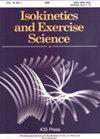老年人肌肉质量指数与身体机能的关系
IF 0.7
4区 医学
Q4 ENGINEERING, BIOMEDICAL
引用次数: 0
摘要
背景:肌肉质量指数(MQI)已被提议作为一种诊断工具,用于检测身体功能受限的个体。目的:我们的目标是检查MQI与身体功能的关系,并将其预测能力与老年人群中其他肌肉力量和质量参数进行比较。方法:对68名年龄在69至89岁之间的健康老年人(34男,34女)进行身体成分、MQI、最大等速同心KES和身体功能测试,包括坐-站(STS)时间、正常和最大步行速度(WS)、定时上下(TUG)和静态平衡。应用Pearson相关性检验肌肉参数之间的关系。进行了包括年龄和性别作为额外协变量的线性回归分析,以评估他们对身体功能的预测能力。结果:MQI与相对KES显著相关(r=0.611,总KES(r=0.829,p<0.001)和腿部瘦组织质量(r=0.690,p<0.001)。MQI不是任何身体功能的显著预测因素(p>0.05)。STS时间是正常WS和TUG时间的显著预测指标(p<0.001)。相对KES是除静态平衡外的所有身体功能的重要预测指标(p<0.01)。没有肌肉参数,只有年龄是静态平衡。模型解释了20.4%-57.3%的因变量方差。结论:MQI是评估腿部瘦组织质量和膝伸肌强度的有用工具,并且优于STS时间。然而,STS时间和相对KES与物理函数的关系比MQI更密切。本文章由计算机程序翻译,如有差异,请以英文原文为准。
The relationship between muscle quality index and physical function in older adults
BACKGROUND: The muscle quality index (MQI) has been proposed as a diagnostic tool to detect individuals at risk of limited physical function. OBJECTIVE: Our goal was to examine the relationship of the MQI with physical function and compare its predictive ability with other muscle parameters of strength and mass in an older population. METHODS: Sixty-eight healthy older adults (34 male, 34 female) aged between 69 and 89 years were tested for body composition, MQI, maximum isokinetic concentric KES and physical function including sit-to-stand (STS) time, normal and maximum walking speed (WS), Timed Up and Go (TUG) and static balance. Pearson’s correlation was applied to examine the relationship between muscle parameters. Linear regression analysis including age and sex as additional covariates was performed to assess their predictive ability for physical functions. RESULTS: MQI correlated significantly with relative KES (r= 0.611, p< 0.001), total KES (r= 0.829, p< 0.001) and leg lean tissue mass (r= 0.690, p< 0.001). The MQI was not a significant predictor for any physical function (p> 0.05). STS time was a significant predictor for normal WS and TUG time (p< 0.001). Relative KES was a significant predictor for all physical functions except static balance (p< 0.001). No muscle parameter and only age was a significant predictor for static balance. Models explained 20.4%–57.3% of variances of dependent variables. CONCLUSIONS: The MQI is a useful tool to assess leg lean tissue mass and strength of the knee extensor muscles and outperforms STS time. However, STS time and relative KES are more closely related to physical function than the MQI.
求助全文
通过发布文献求助,成功后即可免费获取论文全文。
去求助
来源期刊

Isokinetics and Exercise Science
医学-工程:生物医学
CiteScore
1.20
自引率
14.30%
发文量
37
审稿时长
>12 weeks
期刊介绍:
Isokinetics and Exercise Science (IES) is an international journal devoted to the study of theoretical and applied aspects of human muscle performance. Since isokinetic dynamometry constitutes the major tool in this area, the journal takes a particular interest in exploring the considerable potential of this technology.
IES publishes studies associated with the methodology of muscle performance especially with respect to the issues of reproducibility and validity of testing, description of normal and pathological mechanical parameters which are derivable from muscle testing, applications in basic research topics such as motor learning paradigms and electromyography. The journal also publishes studies on applications in clinical settings and technical aspects of the various measurement systems employed in human muscle performance research.
The journal welcomes submissions in the form of research papers, reviews, case studies and technical reports from professionals in the fields of sports medicine, orthopaedic and neurological rehabilitation and exercise physiology.
 求助内容:
求助内容: 应助结果提醒方式:
应助结果提醒方式:


